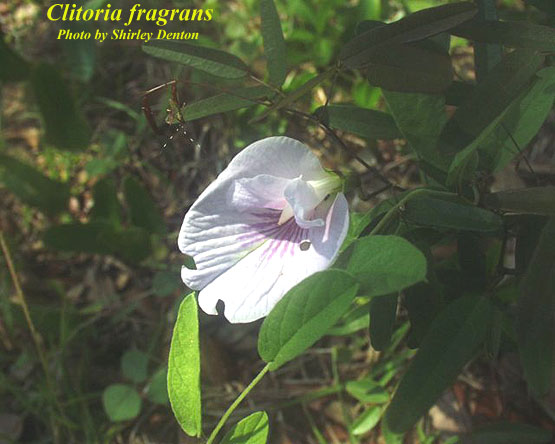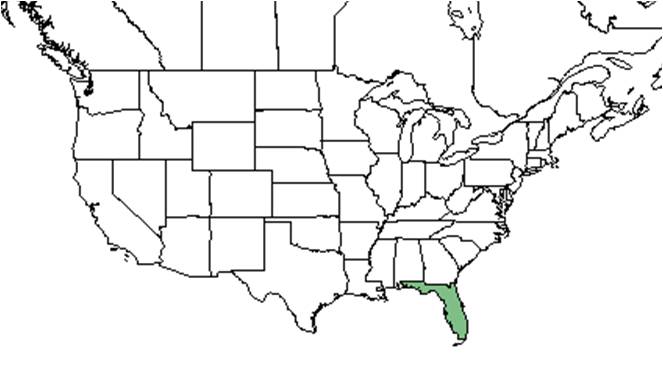Difference between revisions of "Clitoria fragrans"
KatieMccoy (talk | contribs) |
|||
| Line 38: | Line 38: | ||
===Seed dispersal=== | ===Seed dispersal=== | ||
It exhibits ballistic seed dispersal, this results in most of the new individuals coming from plants already established in the population (Lewis 2007). The cleistogamous and chasmogamous seeds have been observed to not have morphological differences (Lewis 2007). Fruits are three sided achenes (Palazzo et al. 2007). | It exhibits ballistic seed dispersal, this results in most of the new individuals coming from plants already established in the population (Lewis 2007). The cleistogamous and chasmogamous seeds have been observed to not have morphological differences (Lewis 2007). Fruits are three sided achenes (Palazzo et al. 2007). | ||
| − | + | <!--===Seed bank and germination===--> | |
| − | ===Seed bank and germination=== | ||
===Fire ecology=== <!--Fire tolerance, fire dependence, adaptive fire responses--> | ===Fire ecology=== <!--Fire tolerance, fire dependence, adaptive fire responses--> | ||
''C. fragrans'' is found in pyrogenic habitats along the Lake Wales Ridge and has a long taproot to increase fire survival<ref name="Natureserve">[[http://explorer.natureserve.org/servlet/NatureServe?searchName=Clitoria+fragrans NatureServe]] Accessed: December 7, 2015</ref>. Fire increases both flowering and population density in plants; however, it has been observed flowering in a site not burned for thirty years<ref name="FWS"/>(Lewis 2007). Plants in long-unburned sites have been observed to rarely produce cleistogamous flowers (Palazzo et al. 2007). Weekley and Menges (2003) observed a moderate resprouting response to fire. | ''C. fragrans'' is found in pyrogenic habitats along the Lake Wales Ridge and has a long taproot to increase fire survival<ref name="Natureserve">[[http://explorer.natureserve.org/servlet/NatureServe?searchName=Clitoria+fragrans NatureServe]] Accessed: December 7, 2015</ref>. Fire increases both flowering and population density in plants; however, it has been observed flowering in a site not burned for thirty years<ref name="FWS"/>(Lewis 2007). Plants in long-unburned sites have been observed to rarely produce cleistogamous flowers (Palazzo et al. 2007). Weekley and Menges (2003) observed a moderate resprouting response to fire. | ||
Revision as of 19:02, 19 January 2016
| Clitoria fragrans | |
|---|---|

| |
| Photo by Shirley Denton, Atlas of Florida Vascular Plants | |
| Scientific classification | |
| Kingdom: | Plantae |
| Division: | Magnoliophyta - Flowering plants |
| Class: | Magnoliopsida - Dicotyledons |
| Order: | Fabales |
| Family: | Fabaceae ⁄ Leguminosae |
| Genus: | Clitoria |
| Species: | C. fragrans |
| Binomial name | |
| Clitoria fragrans Small | |

| |
| Natural range of Clitoria fragrans from USDA NRCS Plants Database. | |
Common name: sweetscented pigeonwings
Contents
Taxonomic notes
The common name, pigeon wings, is due to the flowers' bird-like appearance [1].
Description
C. fragrans is a perennial, erect, suffrutescent herb that is found in scrub and sandhill habitats along the Lake Wales Ridge (Lewis 2007; Small 1926). It is distinguishable from other legumes by its non-twining habit, prominent stipules, three foliate leaves, and resupinate flowers (Frantz 1977; Lewis 2007). It has both chasmogamous and cleistogamous fowers [1].
Distribution
It is endemic to the Lake Wales Ridge and is an endangered species in Florida [2]. The distribution of C. fragrans is limited by the rapidly disappearing scrub habitat due to agriculture and residential development[1].
Ecology
Habitat
C. fragrans can be found in the xeric soils of turkey oak scrubs and sandhills along the Lake Wales Ridge (FSU Herbarium; Menges et al. 2007; Small 1926). It often can be found occupying open, sandy spaces between shrubs, along sandy fire lanes, and between citrus groves (Palazzo et al. 2007; FSU Herbarium). Associated species include Quercus, Gordonia, Vitis, Pinus, Aristida stricta, Quercus laevis and Quercus incana[2] (FSU Herbarium).
Phenology
C. fragrans has both chasmogamous and cleistogamous flowers [1] and has been observed to produce more cleistogamous flowers and fruit than chamogamous structures (Lewis 2007). The chasmogamous flowers are lavender, with darker purplish lines and white throats[3] and can be observed blooming May to June[1](FSU Herbarium). Cleistogamous flowers occur later in the summer through late September [1].
Seed dispersal
It exhibits ballistic seed dispersal, this results in most of the new individuals coming from plants already established in the population (Lewis 2007). The cleistogamous and chasmogamous seeds have been observed to not have morphological differences (Lewis 2007). Fruits are three sided achenes (Palazzo et al. 2007).
Fire ecology
C. fragrans is found in pyrogenic habitats along the Lake Wales Ridge and has a long taproot to increase fire survival[4]. Fire increases both flowering and population density in plants; however, it has been observed flowering in a site not burned for thirty years[1](Lewis 2007). Plants in long-unburned sites have been observed to rarely produce cleistogamous flowers (Palazzo et al. 2007). Weekley and Menges (2003) observed a moderate resprouting response to fire.
Pollination
The following Hymenoptera families and species were observed visiting flowers of Clitoria fragrans at Archbold Biological Station (Deyrup 2015):
Megachilidae: Megachile petulans
Use by animals
C. fragrans is a host plant to the long-tailed skipper[3].
Conservation and Management
C. fragrans is a federally threatened and endangered species in Florida. A major threat to the species is the conversion of habitat on the Lake Wales Ridge to agriculture and urbanization; this also leads to population fragmentation (Palazzo et al. 2007).
In order to prevent further population loss, prescribed fire is suggested[2].
Photo Gallery
References and notes
Deyrup, M.A. and N.D. 2015. Database of observations of Hymenoptera visitations to flowers of plants on Archbold Biological Station, Florida, USA.
Fantz, P.R. 1977. A Monograph of the genus Clitoria (Leguminosae Glycineae) [Ph.D. dissertation]. Univ. Florida. pp. 696-705
Florida State University Robert K. Godfrey Herbarium database. URL: http://herbarium.bio.fsu.edu. Last accessed: October 2015. Collectors: R.K. Godfrey, O. Lakela, Grady W. Reinert, John K. Small, Edgar T. Wherry. States and Counties: Florida: Highlands, Polk. Compiled by Tall Timbers Research Station and Land Conservancy.
Lewis, M.N. 2000. Life History and Reproductive Biology of Clitoria fragrans Relative to Fire History on the Avon Park Air Force Range. University of Central Florida.
Palazzo, A.J., Hardy, S.E., Cary, T.J., and Bashore, T. 2007 A Review of the Growth Habits and Restoration Issues for Clitoria fragrans and Polygonella basiramia. US Army Corps of Engineers Engineer Research and Development Center.
Small, John K.. “A New Butterfly-pea from Florida.”. Torreya 26.3 (1926): 56–57.
Weekley, C.S. and E.S. Menges. 2003a. Species and vegetation responses to prescribed fire in a longunburned, endemic-rich Lake Wales Ridge scrub. Journal of the Torrey Botanical Society
130(4):265-282.